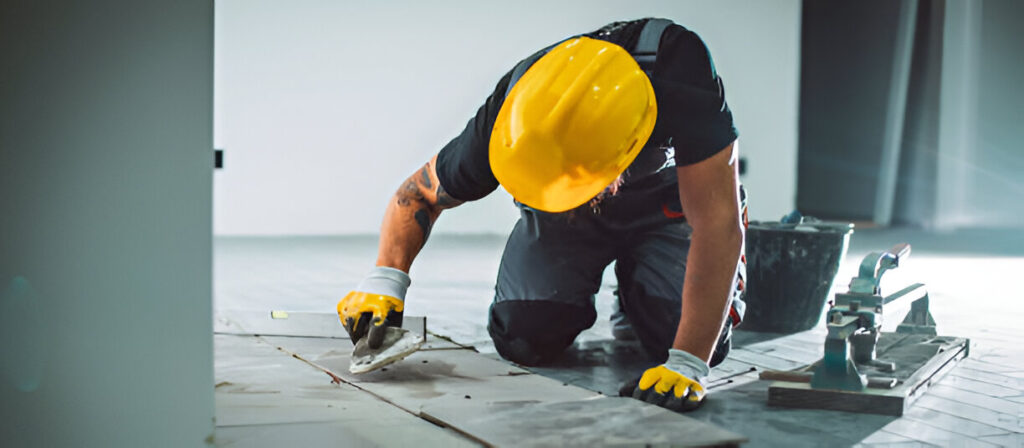
When working on tile projects, using the right tools is essential to achieve professional results. Each tool plays a vital role in creating flawless finishes, from making precise cuts to ensuring tiles are laid evenly. With the proper equipment, you can enhance efficiency and craftsmanship, whether you are a seasoned tiler or a DIY enthusiast.
In this blog, we will explore the top 10 tools for tiling that every professional and hobbyist should have on hand. These tools will not only help you work more effectively but also ensure that your finished project looks stunning and stands the test of time. By investing in quality tiling tools, you set the stage for successful installations, ensuring both durability and aesthetic appeal in your tile work.
10 Essential Tools Every Tiler Should Have in Their Toolbox
Considering these factors, here’s a compilation of 10 crucial tools that every tiling professional should include in their toolkit.
1. Tile Cutter: Precision for a Flawless Finish

A tile cutter is fundamental for creating clean, precise cuts and is suitable for most types of tile, including ceramic and porcelain. It’s available in manual or electric options, with electric models offering added power for tougher materials. Tile cutters allow you to avoid irregular edges and are essential for achieving a high-quality look.
- Electric tile cutters work well for cutting through hard tiles like porcelain and stone.
- Manual tile cutters are more portable and great for smaller jobs.
- Precision cutting is crucial for edge pieces or intricate patterns, avoiding gaps.
- Reduces tile waste, saving money on materials.
2. Trowels: Ensuring Proper Adhesive Application
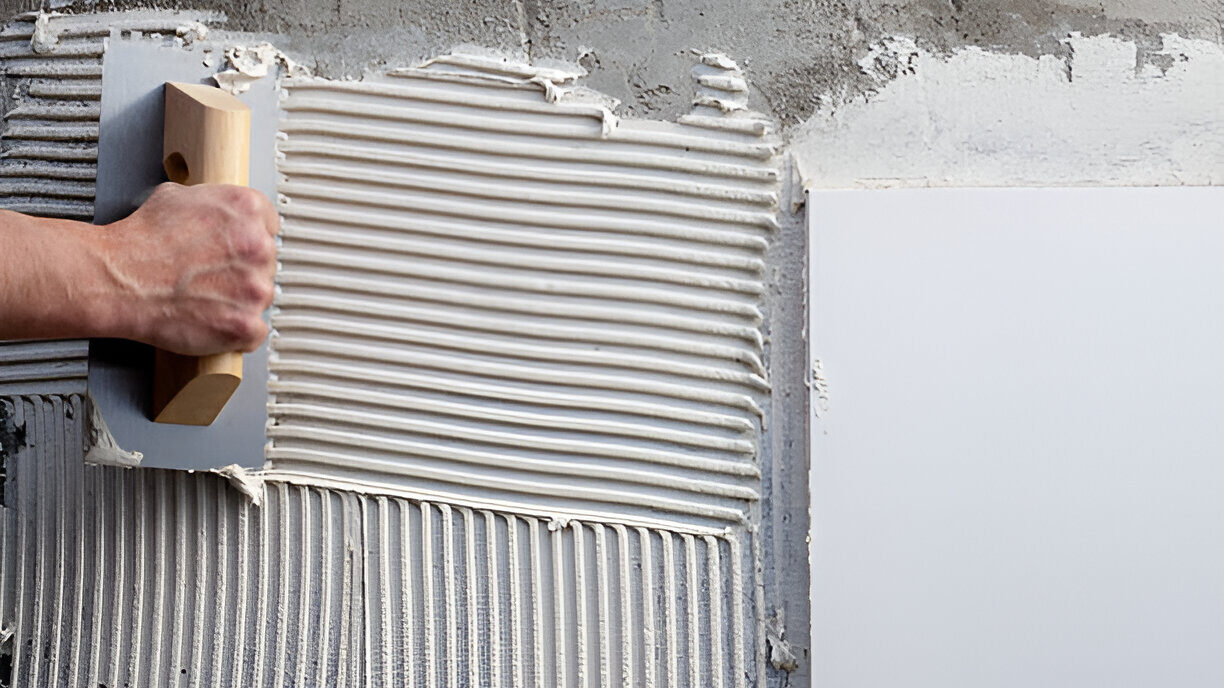
Trowels are critical tools for tiling work as they ensure the adhesive is spread evenly, which provides better adhesion and durability. They come in a range of sizes and notch shapes depending on the tile size and type.
- Square-notch trowels are ideal for larger tiles, spreading adhesive evenly.
- V-notch trowels work well for smaller tiles or mosaic tiles.
- Improves bonding between the tile and surface, reducing the risk of loose tiles.
- Multiple trowel sizes ensure flexibility across various tile projects.
3. Tile Spacers: Uniformity for a Polished Look
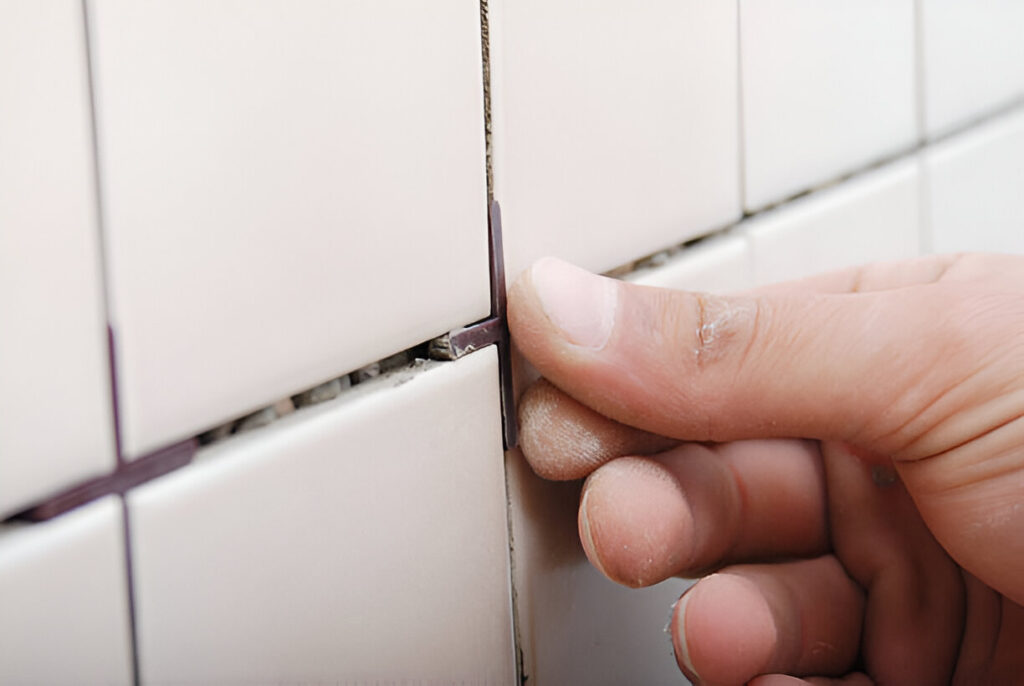
Tile spacers are small but essential, ensuring consistent spacing between tiles for a uniform appearance. They come in various sizes, letting you choose the best fit for your desired grout width.
- Maintains consistent spacing, contributing to a polished, professional look.
- Prevents tiles from shifting during installation.
- Multiple sizes are available, allowing flexibility with grout lines.
- Easy to remove once the adhesive sets, leaving a perfect gap for grouting.
4. Grout Float: Smooth, Even Grouting
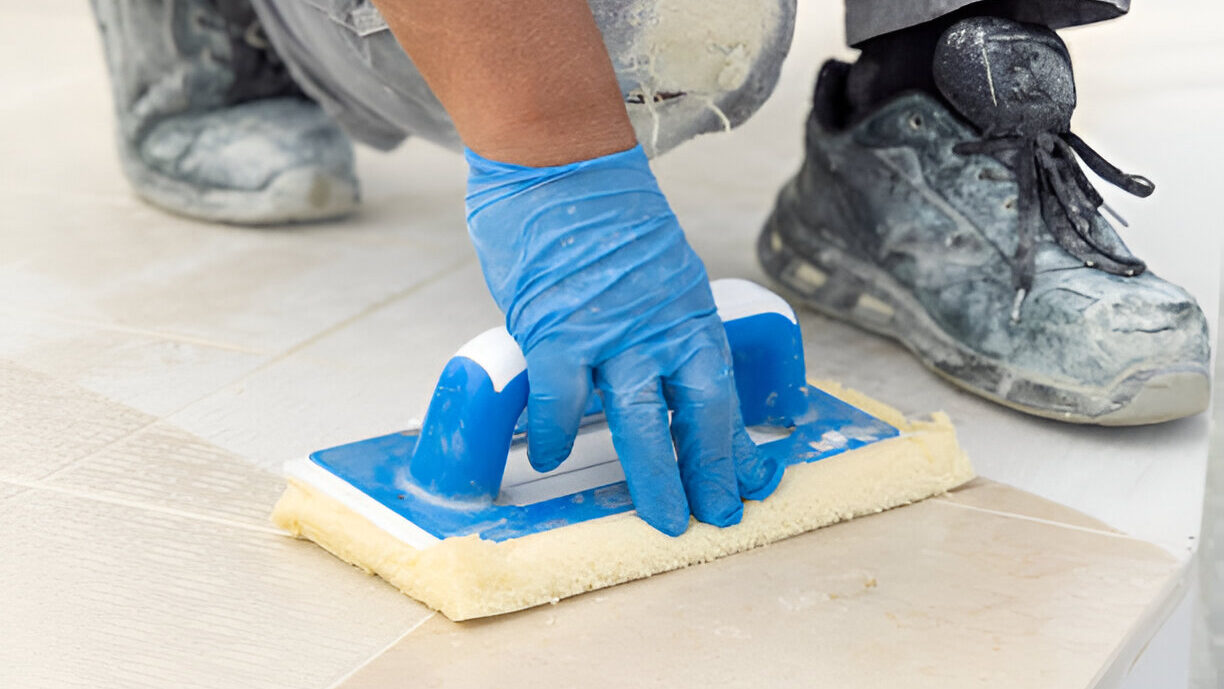
A grout float allows you to press grout into the joints without scratching or damaging the tiles. Made from rubber, it is flexible enough to reach every gap yet sturdy enough for even application.
- Smooth application of grout between tiles for a polished finish.
- Rubber material prevents scratching or damaging tile surfaces.
- Ensures grout is packed tightly, reducing the risk of cracking.
- Helps prevent air pockets, which could weaken the grout over time.
5. Tile Nippers: For Cutting Irregular Shapes
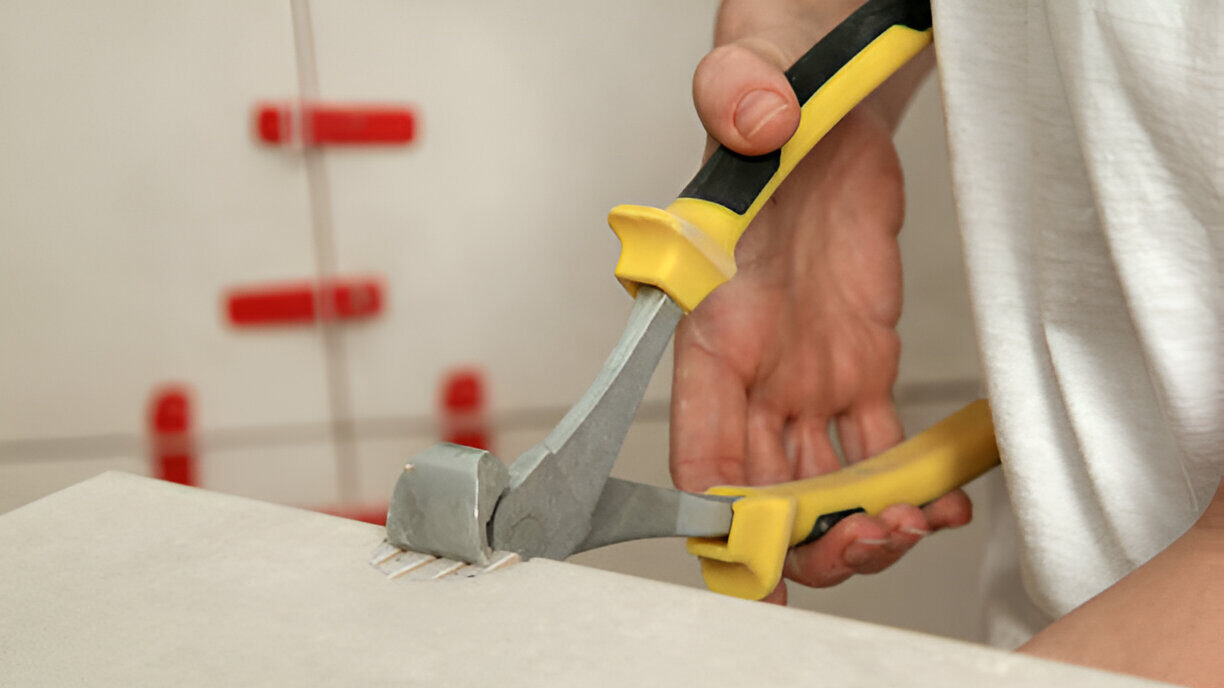
When dealing with tiles around pipes, corners, or other obstacles, tile nippers make it possible to shape tiles with precision. These tile laying tools are crucial for creating complex shapes and cuts.
- Ideal for small cuts around obstacles like pipes or fixtures.
- Designed for intricate shapes that tile cutters may not handle.
- Useful for mosaic tiles and small projects with irregular designs.
- Reduces tile waste, making it easier to work around complex layouts.
6. Rubber Mallet: Gentle, Effective Tile Setting
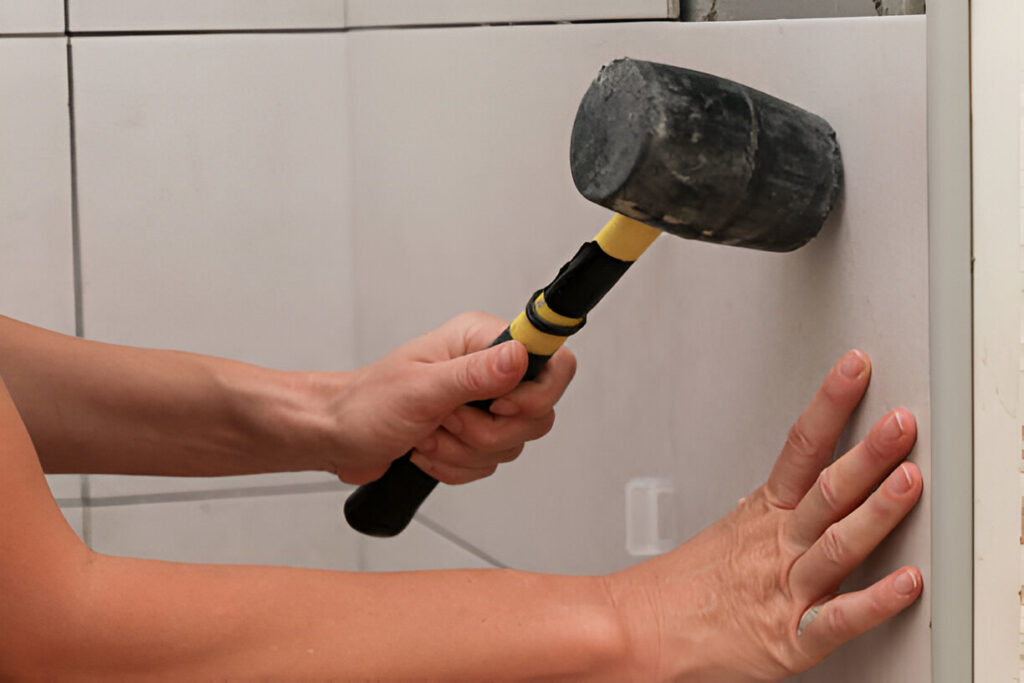
A rubber mallet helps to tap tiles into place without cracking them, an essential step to ensure each tile is level and secure. This tool is particularly important in floor tile installations.
- Prevents tile damage while ensuring secure adhesion to the surface.
- Ensures tiles are level, eliminating potential tripping hazards.
- Useful for aligning large tiles in floor installations.
- Non-marking rubber head won’t leave stains on lighter tiles.
7. Tile Leveling System: Avoiding Uneven Surfaces

A tile leveling system ensures that tiles remain level during installation, preventing a problem known as “lippage,” where edges stick up unevenly. This is essential for safety, especially in floor tile installations.
- Prevents uneven surfaces for a smooth, professional finish.
- Reduces installation time by keeping tiles aligned.
- Improves safety, especially for floors, by preventing tripping hazards.
- Reusable in multiple projects, adding long-term value.
8. Mixing Drill: Consistency for Adhesive and Grout

A mixing drill ensures that adhesives and grout have a uniform consistency, which is essential for strong bonding and a long-lasting installation. It’s a powerful tool for tile work that saves time and energy.
- Provides consistent mixing for stronger adhesion and grout integrity.
- Prevents lumps in adhesive, ensuring a smoother surface.
- Saves time on manual mixing, especially for large jobs.
- Reduces hand strain, making the job easier and faster.
9. Wet Saw: Essential for Heavy-Duty Cuts
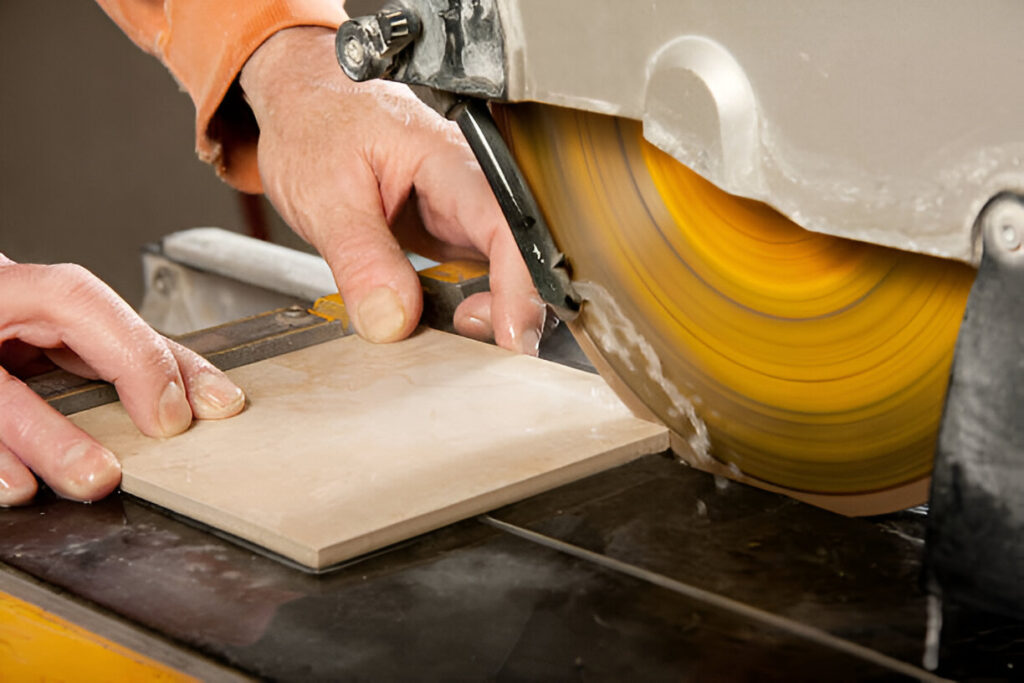
A wet saw is one of the most powerful tiling tools, especially for hard tiles like stone and porcelain. With water running over the blade, it reduces dust and prevents the tile from overheating and cracking.
- Cuts hard tiles efficiently, including porcelain and natural stone.
- Water cooling prevents cracks and extends blade life.
- Offers precision cutting for a clean, professional finish.
- Ideal for large jobs where manual tile cutters may not be sufficient.
10. Safety Gear: Protection for Every Job

Safety gear is essential in any tile installation project, as it protects you from injuries and ensures a safe working environment. Gloves, safety goggles, and knee pads are standard for any tiler’s toolkit.
- Safety goggles protect eyes from dust and flying debris.
- Gloves prevent hand injuries and provide better grip on tiles.
- Knee pads offer comfort during long installations on floors.
- Dust masks keep lungs protected, especially when cutting tiles.
Tips for Choosing the Right Tiling Tools
Selecting the right tools for tiling is crucial for successful projects. Start by considering the types of tiles you’ll be using. Different tile tools cater to specific materials, like ceramic or porcelain. For example, a wet saw is ideal for hard tiles. Ensure you have essential tools for tiling work in your kit, including tile cutters, trowels, and grout floats.
Each tool serves a unique purpose and affects the final look. Evaluate the size of your project, as larger jobs may require more advanced tile installation tools. Don’t forget to invest in quality options for durability and performance. Always choose tools that feel comfortable in your hands to enhance your workflow. This will make your tile projects more enjoyable and efficient. Ultimately, having the right tools needed for tile work will save you time and produce professional results.
Read Also: Top 10 Scaffolding Safety Tips for Construction Sites.
Best Practices for Using Tiling Tools Effectively
To get the most out of your tools for tiling, practice proper techniques. Always read the manufacturer’s instructions for each tool. This ensures you understand its specific use and limitations. When using tile tools, keep them clean and free from debris. A clean workspace will improve your efficiency. Utilize the right tools for tiling work for the specific tasks at hand.
For instance, use a rubber mallet for adjusting tiles gently. This prevents damage and ensures level placement. It’s also vital to maintain consistent spacing with tile spacers. This guarantees a polished appearance. Use your tile installation tools as intended to prevent accidents and mistakes. Regular practice will enhance your skill level, making you more proficient with every project. By following these best practices, you’ll ensure your tiling projects are successful and visually appealing.
Read Also: Types of Scaffolding Used in Construction: Which Is Best?
Maintaining Your Tiling Tools for Longevity
Proper maintenance of your tools for tiling is essential for their longevity. After each use, clean your tile tools thoroughly. Remove adhesive, grout, or tile dust to prevent buildup. Store your tools for tiling work in a dry place to avoid rust or damage. Keep sharp tools, like tile cutters, properly stored to protect their blades.
Regularly inspect your tile installation tools for signs of wear. Replace any damaged tools immediately to ensure safety and efficiency. It’s also wise to periodically lubricate moving parts, especially on electric tools. This keeps them functioning smoothly. For hand tools, sharpening edges will improve their performance. When you care for the tools needed for tile work, you not only extend their lifespan but also enhance their effectiveness. A well-maintained tool kit makes every tiling project easier and more enjoyable.
Apex Contractors Inc.
At Apex Contractors Inc., we specialize in providing top-quality tiling services for both residential and commercial projects. Our team of skilled professionals is dedicated to delivering flawless tile installations that elevate your space. Whether you need new tile floors, backsplashes, or wall tiling, we have the expertise and tools necessary to achieve stunning results.
Call us for your tiling work today! We’re here to discuss your project needs and provide you with a free estimate. Trust Apex Contractors Inc. to bring your vision to life with precision and care. Let’s transform your space together!
